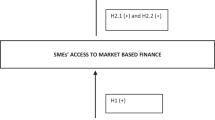Abstract
Yen carry trades have traditionally been viewed in narrow terms purely as a foreign exchange transaction. This paper argues that the carry trade should instead be viewed in the broader context of global credit conditions. We show that the volume of yen funding that is channeled for use outside Japan is mirrored by fluctuations in the size of U.S. broker-dealer balance sheets. Differences in short-term interest rates across currencies help to explain the incidence of the carry trade, as does the measure of implied equity risk given by the VIX index. The conjunction of deteriorating credit conditions in the United States and the weakness of the dollar against the yen in the early stages of the credit crisis of 2007–08 can thus be seen as two sides of the same coin. Both can be seen as consequences of financial sector deleveraging in the United States.


















Similar content being viewed by others
Notes
“Debt Reckoning: US Receives a Margin Call,” Wall Street Journal, March 14, 2008.
See Brunnermeier (2008); BIS (2008); IMF (2008); and Greenlaw and others (2008) for a chronology of the credit crisis of 2007–08.
The index is available at www.markit.com.
See Shin (2008) for the details of the analysis.
The Japan premium explains the very sharp spike upward in the “bills bought” component of foreign banks’ assets, as shown in Figure 7.
The t-statistic is −7.15.and the R2 is 0.34.
There is some evidence that some of the funds captured in the interoffice accounts are used to purchase Japanese securities on the books of the headquarters bank. Thus, not all of the interoffice accounts will reflect funds channeled out of Japan for use overseas.
The reason why we take changes rather than growth rates for the net interoffice accounts is that the series changes sign frequently, with some observations close to zero.
We will see later some independent confirmation of the role of the interest rate differential.
See also Burnside and others (2007) on the excess returns on the carry trade. See Gyntelberg and Remolona (2007) for the evidence of carry trades in other Asian currencies.
References
Adrian, Tobias, and Hyun Song Shin, 2007, “Liquidity and Leverage,” Journal of Financial Intermediation.
Adrian, Tobias, and Hyun Song Shin, 2008a, “Liquidity, Monetary Policy and Financial Cycles,” Current Issues in Economics and Finance, Vol. 14, No. 1, Federal Reserve Bank of New York. Available via the Internet: www.newyorkfed.org/research/current_issues/ci14-1.pdf.
Adrian, Tobias, and Hyun Song Shin, 2008b, “Financial Intermediary Leverage and Value at Risk,” Federal Reserve Bank of New York and Princeton University Working Paper. Available via the Internet: www.princeton.edu/~hsshin/working.htm.
Bank for International Settlements (BIS), 2008, 78th Annual Report (Basel, Bank for International Settlements).
Bernanke, B., 2004a, Central Bank Talk and Monetary Policy, Remarks at the Japan Society Corporate Luncheon, New York, October 7. Available via the Internet: www.federalreserve.gov/boarddocs/speeches/2004/200410072/default.htm.
Bernanke, B., 2004b, The Logic of Monetary Policy, Remarks at the National Economists Club, December 2. Available via the Internet: www.federalreserve.gov/boarddocs/speeches/2004/20041202/default.htm.
Blinder, Alan, 1988, Central Banking in Theory and Practice (Cambridge, Massachusetts, MIT Press).
Brunnermeier, Markus, forthcoming, “De-Ciphering the Credit Crisis of 2007,” Journal of Economic Perspectives.
Brunnermeier, Markus, Stefan Nagel, and Lasse Pedersen, 2009, “Carry Trades and Currency Crashes,” NBER Macroeconomics Annual 2008 (Cambridge, Massachusetts, National Bureau of Economic Research).
Burnside, Craig, Martin Eichenbaum, Isaac Kleshchelski, and Sergio Rebelo, 2007, “The Returns to Currency Speculation,” NBER Working Paper No. 12489 (Cambridge, Massachusetts, National Bureau of Economic Research).
Gagnon, Joseph E., and Alain Chaboud, 2007, “What Can the Data Tell Us About Carry Trades in Japanese Yen?” FRB International Finance Discussion Paper No. 899 (Washington, Board of Governors, Federal Reserve System).
Greenlaw, D., J. Hatzius, A. Kashyap, and H.S. Shin, 2008, Leveraged Losses: Lessons from the Mortgage Market Meltdown, Report of the U.S. Monetary Form, No. 2. Available via the Internet: www.chicagogsb.edu/usmpf/docs/usmpf2008confdraft.pdf.
Gyntelberg, Jacob, and Eli M. Remolona, 2007, “Risk in Carry Trades: A Look at Target Currencies in Asia and the Pacific,” in BIS Quarterly Review, December (Basel, Bank for International Settlements).
International Monetary Fund (IMF), 2008, Global Financial Stability Report, Economic and Financial Surveys (Washington, April).
Jimenez, G., and J. Saurina, 2006, “Credit Cycles, Credit Risk, and Prudential Regulation,” International Journal of Central Banking, Vol. 2, No. 2, pp. 65–98.
Plantin, Guillaume, and Hyun Song Shin, 2006, “Carry Trades and Speculative Dynamics,” London Business School and Princeton University Working Paper.
Shin, H.S., 2008, “Risk and Liquidity in a System Context,” Journal of Financial Intermediation, Vol. 17, No. 3, pp. 315–329.
Additional information
*Masazumi Hattori is director and senior economist, deputy head of economics section, Institute for Monetary and Economic Studies, Bank of Japan. Hyun Song Shin is professor of economics at Princeton University. The authors are grateful to Tam Bayoumi, Bob Flood, Kazuo Fukuda, Dick Herring, Isao Hishikawa, Wataru Takahashi and a referee for their suggestions, and to Tobias Adrian for encouragement and support.




